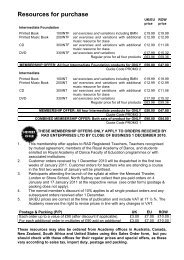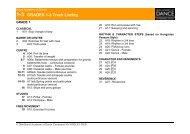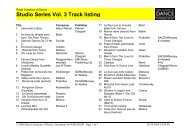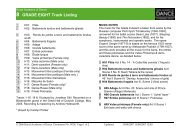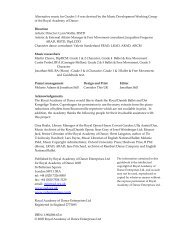to download the guide book in - Royal Academy of Dance Enterprises
to download the guide book in - Royal Academy of Dance Enterprises
to download the guide book in - Royal Academy of Dance Enterprises
You also want an ePaper? Increase the reach of your titles
YUMPU automatically turns print PDFs into web optimized ePapers that Google loves.
musicians. Most classically‐tra<strong>in</strong>ed<br />
musicians are acqua<strong>in</strong>ted with <strong>the</strong><br />
mazurka only through <strong>the</strong> music <strong>of</strong><br />
Chop<strong>in</strong>. He, however, used <strong>the</strong> term<br />
loosely <strong>to</strong> mean three different Polish<br />
dances <strong>in</strong> triple metre, <strong>the</strong> oberek, mazur<br />
and kujawiak. This was by no means<br />
ignorance on Chop<strong>in</strong>’s part – he was well<br />
acqua<strong>in</strong>ted with <strong>the</strong>se dances, and<br />
accord<strong>in</strong>g <strong>to</strong> McKee, was a f<strong>in</strong>e and<br />
enthusiastic dancer himself.<br />
In <strong>the</strong> simplest terms, <strong>the</strong> kujawiak is <strong>the</strong><br />
slowest <strong>of</strong> <strong>the</strong> three, with a smoo<strong>the</strong>r,<br />
lyrical feel, <strong>the</strong> mazur or mazurka is <strong>the</strong><br />
lively dance that is most related <strong>to</strong> those<br />
found <strong>in</strong> <strong>the</strong> ballet reper<strong>to</strong>ire, and <strong>the</strong><br />
oberek is a faster, more athletic dance.<br />
With<strong>in</strong> <strong>the</strong> Mazurkas by Chop<strong>in</strong>,<br />
examples <strong>of</strong> each <strong>of</strong> <strong>the</strong>se types can be<br />
found. It should be noted, also, that <strong>the</strong><br />
mazur existed both as a folk dance and<br />
as a dance for <strong>the</strong> nobility. Throughout<br />
Europe and America, it also became<br />
popular <strong>in</strong> <strong>the</strong> ballroom. The more one<br />
exam<strong>in</strong>es <strong>the</strong> rhythmic structure <strong>of</strong><br />
Chop<strong>in</strong>ʹs waltzes, <strong>the</strong> more <strong>the</strong>y, <strong>to</strong>o,<br />
appear <strong>to</strong> have many characteristics <strong>of</strong><br />
<strong>the</strong> mazurka than <strong>of</strong> <strong>the</strong> waltz, although<br />
this can also be accounted for by <strong>the</strong> fact<br />
that <strong>the</strong> waltz <strong>of</strong> Chop<strong>in</strong>ʹs time was more<br />
likely <strong>to</strong> be <strong>of</strong> <strong>the</strong> early German type.<br />
Our understand<strong>in</strong>g <strong>of</strong> <strong>the</strong> polonaise also<br />
suffers a little from <strong>the</strong> legacy <strong>of</strong> Chop<strong>in</strong>,<br />
who wrote tremendous, grand<br />
polonaises for <strong>the</strong> concert hall which<br />
were both an experiment <strong>in</strong> <strong>the</strong> musical<br />
form, and a vehicle for <strong>the</strong> virtuoso<br />
performer. These are generally <strong>to</strong>o slow<br />
or complex for <strong>the</strong> purposes <strong>of</strong> danc<strong>in</strong>g,<br />
and are exceptional works, ra<strong>the</strong>r than<br />
typical examples. As with <strong>the</strong> mazurka,<br />
<strong>the</strong> polonaise is dance with both folk<br />
18<br />
orig<strong>in</strong>s, and an extended life <strong>in</strong> <strong>the</strong><br />
ballrooms <strong>of</strong> <strong>the</strong> gentry and nobility.<br />
Before reach<strong>in</strong>g <strong>the</strong> ballroom, where<br />
<strong>in</strong>strumentalists would be hired <strong>to</strong><br />
accompany <strong>the</strong> dance, <strong>the</strong> polonaise<br />
would have been accompanied by<br />
s<strong>in</strong>g<strong>in</strong>g, like <strong>the</strong> Polonaise from Halka<br />
already mentioned. The glossary <strong>of</strong><br />
rhythm types <strong>in</strong> Appendix 1 expla<strong>in</strong>s<br />
more about <strong>the</strong> rhythmic characteristics<br />
<strong>of</strong> <strong>the</strong>se dances.<br />
E35: Hop heel hop <strong>to</strong>e and galops<br />
Intro: 4<br />
Title: Dalej bracia, do bułata<br />
Composer: Suchodolski ZKP p.27<br />
TS: 2/4 (2/4)<br />
E36: Pivot and half break<br />
Intro: 4<br />
Title: Krakowiaka (ʹtune no. 2ʹ)<br />
Composer: Trad. Polish PFD p.240<br />
TS: 2/4 (4/4) Rhythm: Krakowiak<br />
E37: Holubetz <strong>in</strong> 3/4 time<br />
Intro: 2 (6)<br />
Title: Ostatni Mazur (The last Mazur)<br />
Composer: Tymulski, PFD p.515<br />
TS: 3/4 (3/4) Rhythm: Mazur(ka)<br />
E38: Stamp and clap with galops<br />
Intro: 4<br />
Title: Miala Baba Koguta<br />
Composer: Trad. Polish ZKP/76<br />
TS: 2/4 (2/4)<br />
E39: <strong>Dance</strong><br />
Intro: 8<br />
Title: Krakowiak ʺNa Krakowską Nutęʺ<br />
Composer: PFD p.652<br />
TS: 2/4 (2/4) Rhythm: Krakowiak




